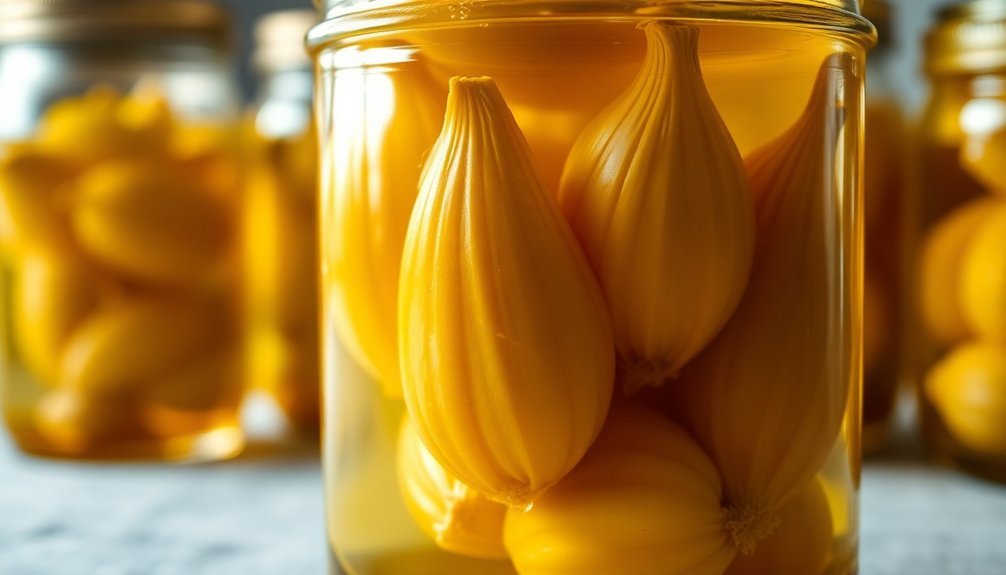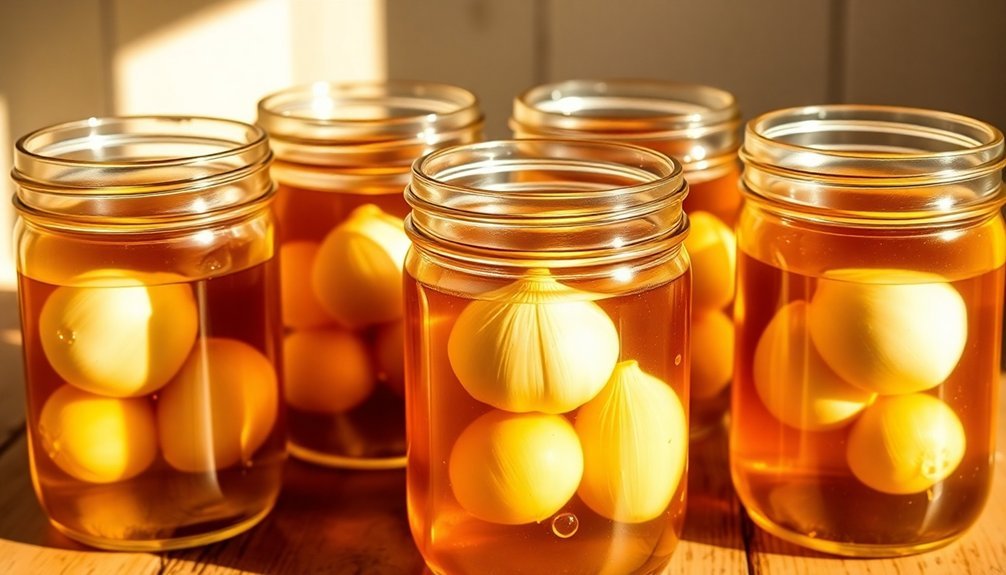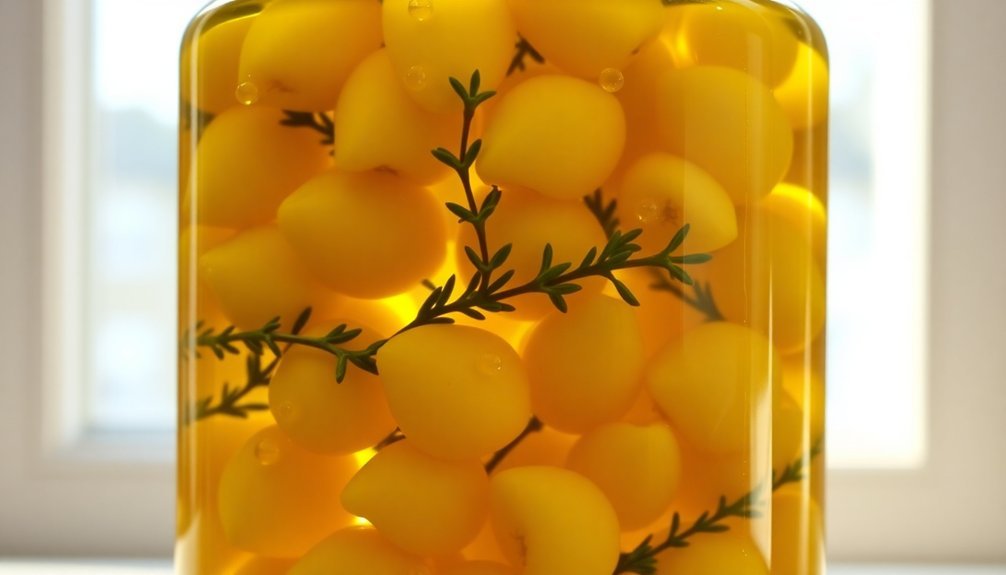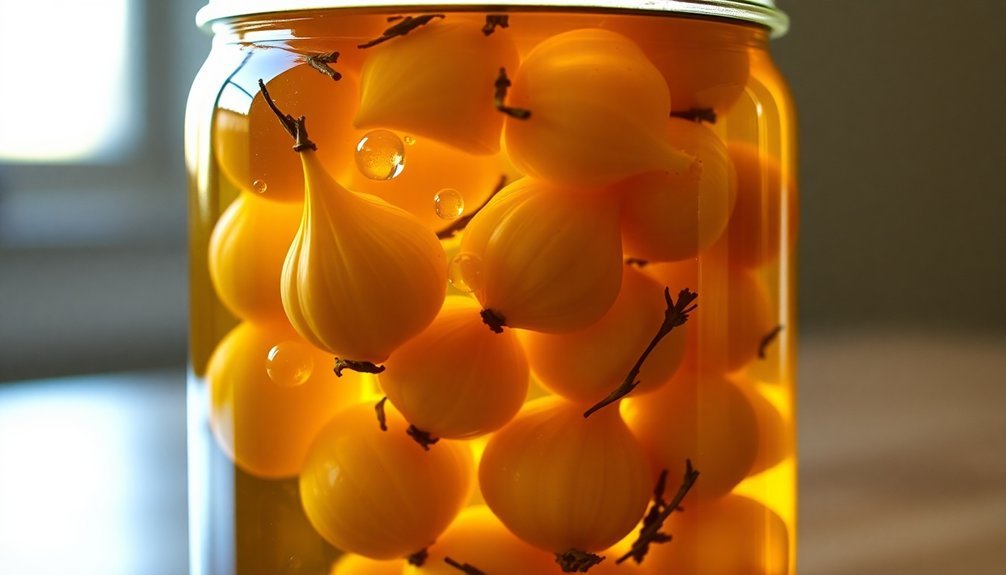Garlic confit oil's impressive shelf life comes from several key preservation factors working together. You'll find that submerging garlic in high-quality oil creates an anaerobic environment that prevents spoilage, while proper refrigeration below 38°F noticeably slows bacterial growth. The oil acts as a protective barrier against oxygen, and when you store it in sterile, airtight glass containers, you're maximizing its preservation potential. You can extend its life even further by freezing portions in ice cube trays, lasting up to 2-3 months. While these basics will get you started, there's much more to mastering the art of garlic confit preservation.
The Science Behind Preservation

Three key factors influence the preservation of garlic confit: the anaerobic environment, temperature control, and oil quality. When you submerge garlic in oil, you're creating an oxygen-free environment that helps preserve the garlic's texture and flavor. Mason jars provide the ideal storage vessel for maintaining this preservation environment.
However, this anaerobic condition requires careful management, as it can create an ideal environment for Clostridium botulinum spores to grow if not handled properly.
Temperature plays an essential role in extending your garlic confit's shelf life. You'll need to keep it refrigerated or frozen to slow down bacterial growth and prevent the development of harmful bacteria.
The initial cooking process, while important for flavor development, isn't enough on its own to eliminate all risks. That's why proper storage temperature is vital.
The quality of oil you use matters greatly in the preservation process. High-quality oil acts as an effective barrier against oxygen while contributing to the overall flavor profile.
However, since garlic confit lacks typical preservative elements like acids or sweeteners, you'll need to be extra vigilant about storage conditions. The absence of these natural preservatives means you can't rely on pH levels to inhibit bacterial growth, making proper temperature control even more important.
Essential Storage Requirements
Proper storage begins with cooling and sealing your garlic confit correctly. Let the mixture reach room temperature before sealing it in an airtight glass container, ensuring all garlic cloves are completely submerged in oil. Duck fat or olive oil works best as the preserving liquid.
You'll need to avoid sealing while hot to prevent unwanted condensation that could lead to spoilage.
Temperature control is essential for your garlic confit's longevity. Store it immediately in your refrigerator at a temperature below 38°F, preferably on the back of the bottom shelf where it's consistently cold.
For extended preservation, you can freeze portions in ice cube trays, which will keep for 2-3 months.
Here's what you'll need to focus on for ideal storage:
- Clean, sterile glass Mason jars or containers
- An accurate refrigerator thermometer to maintain proper temperature
- Airtight seals to prevent oxygen exposure
- Proper handling techniques to avoid contamination
Low Temperature Effects

Maintaining low temperatures throughout the cooking and storage process plays an essential role in your garlic confit's quality and safety. When you cook garlic cloves in olive oil at around 250°F, you'll create the perfect environment for preserving flavor while preventing excessive browning. This slow cooking process, typically lasting 1-2 hours, helps break down sulfur compounds, resulting in sweeter, more tender garlic.
You'll find that low temperatures are important in controlling bacterial growth, particularly Clostridium botulinum spores. While low-temperature cooking doesn't completely eliminate the risk, storing your confit below 40°F in the refrigerator greatly reduces the chance of bacterial contamination. The CDC reports annually that around 25% of botulism cases come from food sources.
If you're looking for even longer preservation, you can freeze your garlic confit.
The controlled temperature during cooking and storage won't just keep your confit safe – it'll also preserve its delicate flavors and textures. You'll notice your garlic remains soft and spreadable, while the infused oil maintains its aromatic properties.
When stored properly at low temperatures, your garlic confit can last several weeks in the refrigerator or several months in the freezer.
Oxygen Barrier Properties
Beyond temperature control, the oil in garlic confit serves as a powerful oxygen barrier that considerably extends its shelf life. When you completely submerge garlic cloves in oil, you're creating an anaerobic environment that protects them from oxidation and spoilage. This preservation method has been proven effective, though it requires careful management to prevent botulism risks.
The oil barrier works by:
- Creating an impenetrable seal that blocks oxygen from reaching the garlic
- Maintaining consistent moisture levels in the cloves
- Slowing down bacterial metabolic processes
- Preserving the garlic's natural flavors and textures
You'll find that properly stored garlic confit can last up to two weeks in your refrigerator, while freezing extends its life to several months. The oil won't freeze solid, making it convenient to portion out as needed.
As an added bonus, you'll get versatile garlic-infused oil that you can use in various dishes. Remember to always store your confit in airtight containers to maintain the oxygen barrier's effectiveness and check regularly for any signs of spoilage, despite the oil's protective properties.
Safe Preparation Methods

For safe garlic confit preparation, following precise methods is essential to prevent foodborne illness and guarantee ideal preservation.
You'll need to begin by thoroughly peeling your garlic cloves, removing their brown root ends, and discarding any damaged portions. Once you've prepared the garlic, place it in a medium saucepan and completely submerge it in oil.
You must maintain a consistent low-heat cooking process, keeping the oil at a gentle simmer with minimal bubbling for about 45 minutes. Watch the garlic carefully to prevent burning, and remove it from heat once it's tender.
Let everything cool completely while still in the pan.
After cooling, you'll need to transfer your garlic confit to a sterile jar, ensuring the garlic remains fully covered with oil. Store it in the refrigerator immediately, where it'll keep for 2-3 weeks.
If you're planning for longer storage, you can freeze your garlic confit, extending its shelf life to 3-6 months or more.
Remember to always use clean utensils when removing garlic cloves to avoid contamination, and keep the jar away from heat and direct sunlight.
Balancing Oil and Acid
Successfully balancing oil and acid levels in garlic confit plays an essential role in both preservation and flavor development. When you're preparing garlic confit, the oil acts as a protective barrier against bacteria while maintaining the garlic's texture and taste.
Adding a small amount of acid, like lemon juice or vinegar, creates an environment that's less favorable for harmful bacteria, particularly botulinum.
The synergistic relationship between oil and acid offers several preservation benefits:
- Oil provides complete coverage, preventing air exposure and oxidation
- Acid helps inhibit bacterial growth while enhancing flavor
- Together, they extend shelf life substantially
- The combination maintains both safety and quality during storage
You'll need to guarantee proper storage practices to maximize these preservation benefits. Store your garlic confit in airtight containers in the refrigerator at 40°F (4°C) or below.
If you won't use it within a few weeks, consider freezing it for longer storage. Always label your containers with dates and regularly inspect for any signs of spoilage, such as unusual odors or mold growth, even with proper oil and acid balance.
Optimal Container Selection

When storing garlic confit safely, choosing the right container becomes essential for maintaining both quality and shelf life. Glass containers, particularly Mason jars and glass storage containers, are your best option because they won't absorb flavors or odors from the garlic.
While you can use plastic containers with tight-fitting lids, they're less ideal for long-term storage. You'll want to guarantee your container has an airtight seal to prevent oxidation and contamination. The lid must fit tightly, whether you're storing your garlic confit in the refrigerator or freezer.
Keep the garlic completely submerged in oil to maintain anaerobic conditions and prevent spoilage. Before transferring your garlic confit, sterilize your containers to eliminate potential contaminants.
You'll need to store the sealed containers in the refrigerator immediately after filling them. If you're planning for longer storage, you can freeze the confit for up to three months. When using silicone containers or ice cube trays for freezing, transfer the frozen portions to an airtight container afterward.
Avoid metal containers, as they may react with the garlic and affect the quality of your confit.
Extended Shelf Life Techniques
To maximize your garlic confit's shelf life, you'll need to maintain strict temperature control below 38°F in the refrigerator and consider freezing for long-term storage.
You can preserve the oil's quality by ensuring it completely covers the garlic cloves, creating an effective barrier against oxidation and bacterial growth.
Using clean, airtight containers with proper seals will protect your confit from contamination and help maintain freshness for several weeks in the refrigerator or months in the freezer.
Proper Temperature Control Methods
The safety and longevity of garlic confit depends on precise temperature control throughout its storage period. You'll need to monitor the temperature carefully, as improper storage can lead to dangerous botulism toxins.
When you've finished preparing your garlic confit, let it cool to room temperature before transferring it to the refrigerator, where it must stay below 38 degrees Fahrenheit.
For ideal preservation, you've got two main temperature-controlled storage options:
- Refrigeration, which keeps your confit safe for up to two weeks when stored in an airtight container with the garlic fully submerged in oil
- Freezing, which extends shelf life to several months and helps prevent botulism spore formation
- Portioning into ice cube trays before freezing, making it convenient to thaw only what you'll use
- Adding an oil cap and optional lemon juice before storing to create an extra preservation barrier
Remember to thaw frozen garlic confit in the refrigerator, never at room temperature.
Whether refrigerated or frozen, you'll need to check regularly for signs of spoilage and verify the garlic remains completely covered by oil to maintain its safety and quality.
Oil Quality Preservation
Preserving the quality of your garlic confit oil starts with selecting premium extra virgin olive oil (EVOO) and implementing proper storage techniques. EVOO's low acidity level of 0.8% and high antioxidant content make it the ideal base for your confit, as its chemical composition helps preserve both the garlic and the oil itself.
To maintain oil quality, you'll need to focus on proper storage methods. Keep your garlic confit in sterilized jars with tight-fitting lids, ensuring the garlic is completely submerged in oil at all times.
Store the jars in a cool, dark place away from heat sources, and always refrigerate immediately after preparation. Adding a small amount of lemon juice can help maintain suitable acidity levels for preservation.
Monitor your confit regularly for any signs of spoilage, such as unusual odors or mold. While properly stored garlic confit can last several weeks in the refrigerator, it's best to use it within four days for ideal safety and quality.
The cold-pressed nature of EVOO, combined with its natural polyphenols, contributes to extended shelf life, but proper handling and storage remain essential for maintaining the oil's integrity.
Airtight Storage Solutions
Proper airtight storage serves as your garlic confit oil's first line of defense against spoilage and contamination.
You'll want to choose containers made of non-reactive materials, with dark glass being the ideal choice for blocking light while preventing any chemical reactions. Stainless steel containers also work well, but avoid plastic or reactive metals like iron or copper that can compromise your oil's quality.
To maximize shelf life, confirm you're using containers with effective sealing mechanisms:
- Screw caps or pressure caps with rubber gaskets
- Airtight seals that minimize air contact
- Smaller bottles for portions you'll use quickly
- Tight-fitting lids that prevent oxidation
Store your garlic confit oil in the refrigerator to prevent bacterial growth and botulism.
If refrigeration isn't possible, keep it in a cool, dark place with temperatures between 57°F and 70°F. Always keep the garlic cloves completely submerged in oil and consider adding a small amount of lemon juice as a preservative.
You can extend the shelf life up to 2 months by freezing, but for best freshness, use the oil within 4 days to a few weeks.
Risk Prevention Strategies

When making garlic confit, implementing robust safety measures proves essential for preventing botulism and other foodborne risks. You'll need to focus on three critical areas: preparation, storage, and monitoring.
During preparation, verify you're using sterile equipment and high-quality oil. Cool your confit immediately after cooking, and transfer it to clean mason jars, making sure the garlic cloves remain fully submerged in oil.
Never leave your garlic confit at room temperature, as this creates ideal conditions for C. botulinum spore germination.
Store your confit properly by keeping it refrigerated below 50°F (10°C) for up to two weeks, or freeze it for longer storage. You'll want to use an airtight container with a tight-fitting lid.
If you're planning to keep it refrigerated, make only what you can use within two weeks to minimize risk.
Monitor your confit regularly for signs of spoilage, such as bulging lids, off odors, or gas production. If you notice any of these warning signs, don't take chances – discard the entire batch immediately.
Keep the oil topped up to maintain full submersion of the garlic cloves, and always store both components in the refrigerator.
Cold Storage Benefits
Inside your refrigerator, cold storage creates an ideal environment for extending your garlic confit's shelf life. The low temperatures considerably slow down bacterial growth and enzymatic reactions that could otherwise spoil your preserved garlic and oil mixture.
You'll notice that proper cold storage helps maintain the rich, mellow flavor and soft texture of your confit while preventing unwanted changes.
When you store your garlic confit in the refrigerator, you'll benefit from:
- Reduced microbial activity that prevents spoilage and keeps your confit safe for consumption
- Minimized enzymatic reactions that help preserve the garlic's natural texture and flavor profile
- Extended shelf life that lets you enjoy your confit for several weeks or even months
- Better quality retention that maintains the oil's clarity and the garlic's tender consistency
Your refrigerator's controlled environment will help coordinate the preservation process effectively, making your garlic confit more stable and reliable for long-term storage.
The cold temperature guarantees that both the oil and garlic maintain their desired characteristics while preventing the development of harmful bacteria that could compromise food safety.
Quality Maintenance Tips

Maintaining your garlic confit's quality begins with meticulous ingredient selection and proper handling techniques. You'll want to choose fresh garlic cloves without any signs of spoilage and pair them with high-quality extra virgin olive oil. Select fresh herbs like rosemary or thyme to enhance the flavor profile while ensuring all ingredients are free from contamination.
To preserve quality during preparation, you'll need to cook the garlic at a consistent 250°F (121°C) for 1½ to 2 hours until it reaches a tender, jammy consistency. Use sterilized equipment throughout the process, including clean utensils, jars, and containers.
When checking for doneness, use a sharp knife to pierce the cloves carefully, looking for a golden color and soft texture.
Once your garlic confit is ready, transfer it immediately to an airtight container and refrigerate. You can extend its quality by adding a small amount of lemon juice or vinegar to the oil.
Monitor your confit regularly for any changes in color, texture, or smell, and plan to use it within two weeks. Don't leave it at room temperature, as this can quickly compromise its quality and safety.
Long-Term Storage Solutions
You'll get the most extended shelf life from your garlic confit by freezing it in portioned containers, which can preserve it for several months while preventing bacterial growth.
For refrigerated storage, you can keep your garlic confit fresh for up to two weeks by storing it in airtight glass containers immediately after it cools to room temperature.
Whether you choose freezing or refrigeration, it's essential to avoid room temperature storage entirely, as this creates ideal conditions for dangerous botulism toxins to develop.
Freezing For Extended Life
For long-term preservation, freezing garlic confit offers a reliable storage solution that extends its shelf life considerably. When you're ready to freeze your garlic confit, let it cool to room temperature first, then transfer it to freezer-safe containers, leaving about ½-inch of headspace.
Make sure you're using containers with tight-fitting lids and label them with the date. Store your frozen garlic confit at 0°F (-18°C) or below, and you'll want to keep it in a freezer with consistent temperature control. This method helps inhibit microorganism growth and reduces botulism risk, though proper handling remains essential.
Here's what you need to know about using frozen garlic confit:
- Thaw it gradually in the refrigerator or over low heat
- Use thawed confit immediately or refrigerate for short-term use
- The infused oil maintains its flavor profile and can be used for cooking
- Always check for signs of spoilage before using, even after freezing
When you're ready to use your thawed garlic confit, it'll work perfectly in various recipes. The oil remains suitable for sautéing, dressings, or as a flavor enhancer.
Remember to keep thawed portions refrigerated and use them within a few days.
Cold Storage Methods
Proper cold storage serves as a cornerstone for preserving garlic confit safely over extended periods. You'll need to maintain temperatures below room level to effectively slow bacterial growth and prevent botulism, making refrigeration your primary storage method for short-term preservation.
When storing your garlic confit, you'll want to use sterile, airtight containers – glass jars work particularly well. These containers protect against contamination and maintain the necessary anaerobic conditions.
Don't worry if you notice the olive oil solidifying in cold storage; this is completely normal. The oil will return to its liquid state once it reaches room temperature, and this process won't affect the quality of your confit.
You can expect your refrigerated garlic confit to last up to two weeks when stored properly, though unopened containers can maintain quality for 3-6 months in cold storage before requiring freezing.
It's crucial to keep your confit in a dark place and regularly check for any signs of spoilage. Once you've opened a jar, you should use its contents within a month, ensuring you're always maintaining proper cold storage conditions.
Frequently Asked Questions
Can I Reuse Garlic Confit Oil for Making a Fresh Batch?
You shouldn't reuse garlic confit oil for a new batch, as it poses botulism risks and may have degraded quality. Instead, use fresh oil to guarantee safety and better flavor in your next confit.
Does Flavoring Garlic Confit With Different Herbs Affect Its Shelf Life?
No, adding herbs to your garlic confit won't affect its shelf life. As long as you're properly storing it in the refrigerator and keeping the garlic fully submerged in oil, your flavored confit remains safe.
What Happens if My Garlic Floats to the Top?
If your garlic floats, you'll need to keep it submerged in oil to prevent spoilage. Use an oil-soaked paper towel to weigh it down, ensuring it stays in an anaerobic environment for safety.
Can I Mix Different Types of Oils When Making Confit?
Yes, you can mix different oils when making confit, but keep in mind that each oil has a unique smoke point and flavor profile. It's best to choose oils with similar cooking temperatures for consistent results.
Should I Sterilize Garlic Cloves Before Making Confit?
Yes, you should sterilize your garlic cloves before making confit. Clean and trim them thoroughly, discard any damaged pieces, and make certain they're free from dirt to prevent contamination and reduce the risk of botulism.
In Summary
Your garlic confit oil's impressive shelf life comes from proper preparation and storage techniques you've followed. By slow-cooking the garlic in oil at low temperatures, you've created an oxygen barrier that prevents spoilage. When you store it in an airtight container in the refrigerator, you're further blocking bacterial growth. Remember, while it can last up to four months, you'll need to watch for any signs of spoilage.





Leave a Reply